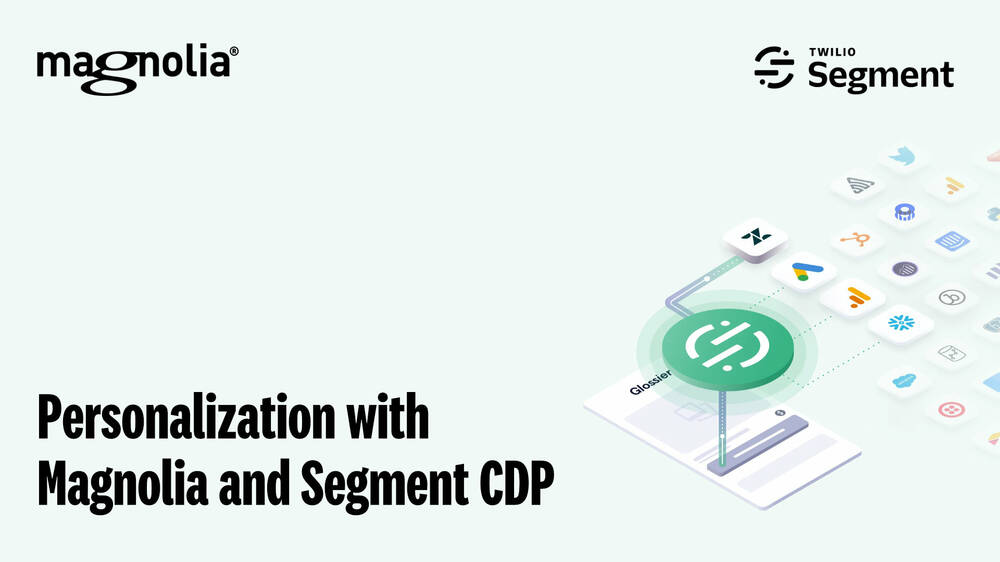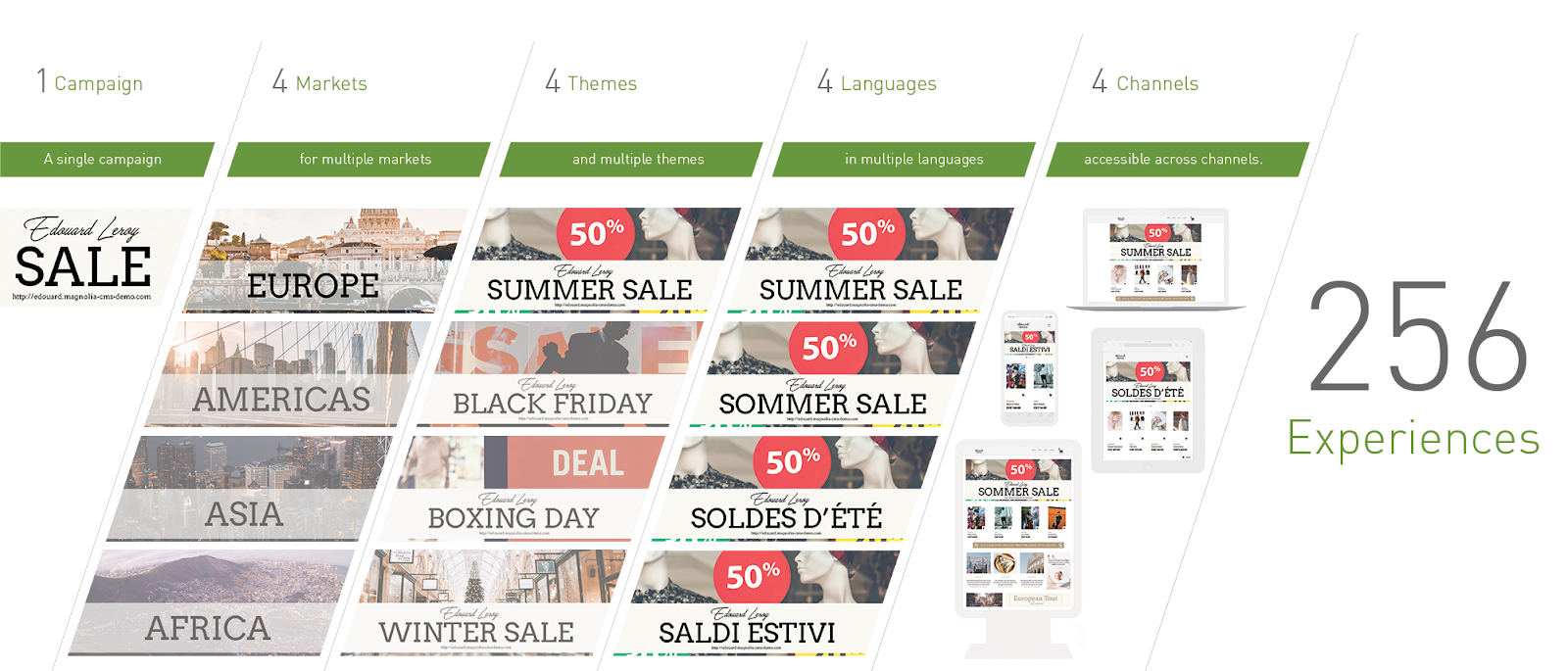- Jul 5, 2024
- 8 min
Hyper personalization: Next level website personalization with Magnolia
Magnolia in action
Take 12 minutes and a coffee break to discover how Magnolia can elevate your digital experience.
Hyper-personalization directly influences buying behavior and customer loyalty. Over three-quarters of consumers are more likely to consider purchasing from brands that personalize their journey. Thus, hyper-personalization matters more than ever for companies looking to improve customer engagement and retention and increase conversation.
Did you know that Customer Data Platforms (CDPs) can easily be integrated with Magnolia? Magnolia comes with a robust set of out-of-the-box features for personalization. Discover how easy it is to serve tailored content and experiences from our 2-minute demo.
Magnolia aids brands in delivering one-to-one personalization by helping them define audience segmentation and targeting, establish baselines for understanding user intent, match content delivery to the buyer journey, and personalize multi-channel campaigns.
A personalized digital experience can mean many different things. With the surge in digital behaviors, the bar has been raised, and the closer organizations get to the consumer, the bigger the gains.
Surface-level personalization is now the norm as 71% of consumers expect companies to deliver personalized interactions, but deep, hyper-personalization is what companies need to deliver to grow customer lifetime and “stay in the game”.
Brands need to demonstrate they know their customers on a personal level and are invested in the relationship, not just in a one-time transaction. 72% of shoppers said they expect the businesses they buy from to recognize them as individuals and know their interests.
For consumers, hyper-personalization includes actions like checking in post-purchase, asking for a review, sending timely communication tied to key moments, offering relevant products/services recommendations, tailoring messages to their needs and based on the behavior online, personally addressing communications and so much more.
However, what many developers fail to see is that the solution to delivering a personalized browsing experience lies less in the tools, and more in the techniques. In this article, we’re delving into how large companies can heighten their personalization efforts.
One-to-one web personalization
One-to-one personalization, also known as hyper-personalization, entails going above and beyond birthday emails to give consumers a truly personalized experience. It involves capturing user intent and personalizing the customer’s experience—i.e, the next steps in their journey—based on that data. The next stage of web content personalization.
During a recent webinar, which is available to view here, I noted that personalization is about listening to your visitors and seeing how they respond to your content. Personalization helps you determine the visitor’s intent toward your content so you can deliver content that matches that intent in real time.
Most content is delivered at one of the following four levels of personalization:
No personalization: All customers receive the same experience.
Basic segmentation: Customers receive content based on a single data point
- such as location or device type.
Advanced segmentation: Customers receive content based on multiple data points
- such as browser history
- order history
- and customer data.
One-to-one personalization: Customers receive content based on “segments of one” as the CMS delivers content by listening to and addressing a customer’s intent.
I also stated that personalization drives a higher conversion rate and reduces bounce rates. It's about ensuring customers stay longer on your site, get more out of it, and, in the end, buy more.
80% of business leaders consider that buyers spend more when their experience is personalized, according to Statista’s 2024 report on the “State of personalization among businesses worldwide”. The same survey outlines that 62% of the business leaders interviewed emphasized the favorable impact on customer retention.
Personalization is a game-changer because it helps boost visitor engagement by delivering relevant content rather than just any content.
Your step-by-step guide to personalization
Download this free guide on how to get started with web personalization
Magnolia CMS personalization helps numerous brands deliver one-to-one personalization in four ways:
Defining audience segmentation and targeting;
Establishing baselines for understanding user intent;
Matching content delivery to the buyer journey based on user intent;
Personalizing multi-channel campaigns.
Now let’s delve into details.
Segmentation and targeting
A foundational marketing strategy may treat the market as a monolithic whole.
An intermediate strategy looks at market segments.
An advanced marketing strategy targets individual segments and delivers content to the relevant segments the client wishes to target.
Personalization helps marketers determine their targets and deliver relevant content to those segments.
Marketers can determine their segments based off of several variables:
Geographic (city, country, language, climate, etc.);
Demographic (age, gender, income, education, etc.);
Behavioral (frequency, recent engagement, source, buyer stage, etc.);
Psychometrics (intent, preferences, etc.).
Once a marketer determines the segments they want to target, the next step is to determine their priorities, such as:
Potential to meet business goals;
Value to meet profit expectations;
Effort (time, money, etc.) to implement personalization.
Magnolia allows users to establish content by visitor priority. For instance, a marketer could have three segments to target:
Explorer/First-time visitor;
First-time buyer;
Repeat customer.
For each segment, the Magnolia user can determine a user intent, a marketing goal, and the desired action or conversion. In this example, the user intent for the Explorer is to learn about the products, the marketing goal is to inform them timely and comprehensively, and the conversion is to get them to sign up for offers.
To help brands unify their customer data on every channel and touchpoint, Magnolia integrates with Customer Data Platform (CDP) technology such as Segment (formerly Twilio). As the Customer Data Platform, Segment allows you to track and collect data about your customers (thought events) and send that data to Magnolia (as personalization traits). Editors will be able to use Magnolia’s out-of-the-box personalization features to serve tailored content and experiences based on the insights from Segment.
Watch the 2-minute video below to get an overview of personalization with Magnolia and Segment CDP:

Understanding intent
Marketers worry about the scalability of measuring each visitor's intent. But with the use of Magnolia's scoring model, you can break intent down into content consumption, purchase and browsing history, and element interactions.
The Magnolia scoring module uses this data to create a fine granular measurement of user intent by calculating a “User Journey Score”. This score is based on the recency of the visitor’s view of the page, as well as the frequency that the visitor has seen the page.
Content pools
Personalization doesn't mean creating massive amounts of content for every persona you have. Instead, marketers can use content pools to apply Magnolia’s scoring module at scale.
Marketers can create a pool of content for the different stages of the funnel and Magnolia will deliver it to the visitors according to where they are in the sales funnel. For instance, when you look at a typical sales funnel, you can divide it into top, middle, and bottom. Customers come into the top of the funnel, move down toward the middle as they make their buying decisions, then filter down to the bottom when they make their purchases.
In terms of content management, the top of the funnel usually consists of materials, including:
How-to guides
Videos
Articles
Webinars
Content for the middle of the funnel consists of:
Product pages
Demos
Pricing information
Content for the bottom of a funnel consist of:
Case studies
Product reviews
Calculators
Special events
You can easily create or bring all these types of content into Magnolia, tag and organize them, and leverage them for personalization. Using the user journey score, you can individualize the experience and serve the most appropriate content for the stage in the buyer journey.
Omni-channel delivery
Let’s say you’re launching a new product line, with content and digital assets that need to be delivered globally but adapted to local sites, different languages, and multiple devices. With a traditional CMS, such a project would be incredibly difficult—but that’s not the case with Magnolia.
The Magnolia campaign manager allows users to manage campaigns across channels, geographic regions, and languages. For example, a campaign can be configured to run on mobile devices, tablet devices, and smartwatches in four different geographical locations and languages. Moreover, each channel could be given its own theme and user experience. Finally, Magnolia’s campaign manager enables marketers to manage all of these campaigns from one place.

The Magnolia campaign manager can also bring specific products to the top of the page, based on the campaign and the targeting variables. Magnolia’s ability to bring up relevant products and services can help to increase conversions and encourage customers to return to the site to make future purchases.
The system can also display campaigns based on the customer's previous buying history, i.e., banners and products relevant to the customer’s previous purchases.
Magnolia's personalization capabilities are headless ready, meaning that you can create your customer experiences as standalone applications built with modern frontend technologies - while still empowering your marketers to comfortably personalize and preview the experience within a full WYSIWYG editing interface.
We recommend this blog article if you’re a developer and want to dive deep into headless personalization with Magnolia.
So, for marketers looking to deliver a hyper-personalized experience to their visitors while also making the process easier for themselves and their enterprise CMS management team, Magnolia provides all the right answers. If you’re currently personalizing based on a few data points and wish to truly meet your customers across channels and individualize the experience based on their journey, look no further.









